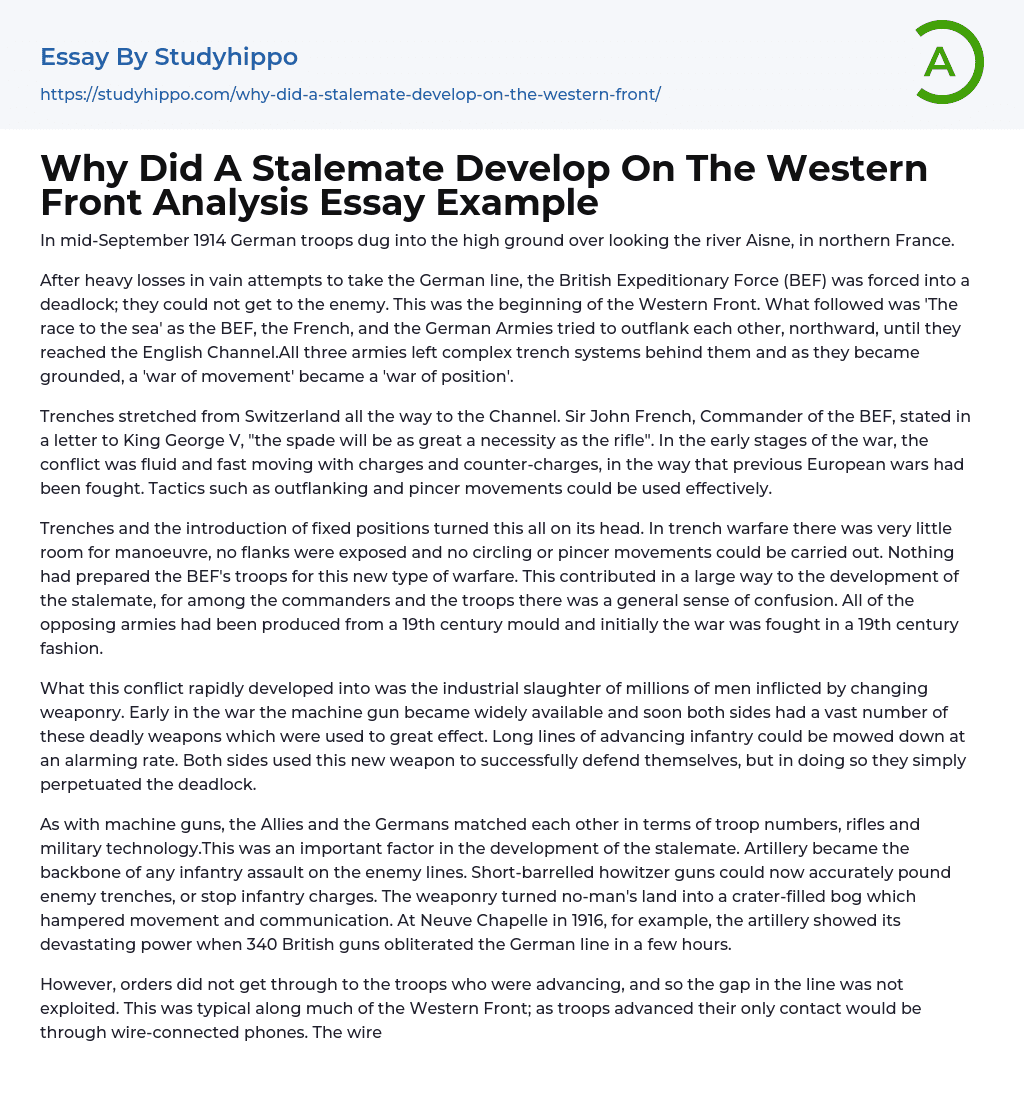

Why Did A Stalemate Develop On The Western Front Analysis Essay Example
In the north of France, in September 1914, German troops dug up a raised location that had a view over the Aisne River.
Following their heavy losses in unsuccessful efforts to breach the German line, the British Expeditionary Force (BEF) found themselves in a stalemate and unable to reach their enemy, marking the inception of the Western Front. The ensuing "race to the sea" saw the BEF, French, and German Armies vying to outflank each other and move northward until they reached the English Channel. This resulted in the creation of intricate trench networks by all three armies, leading to a shift from a "war of movement" to a "war of position."
During the initial stages of the war, traditional European tactics like outflanking and pincer movements could still be applied despite ongoing charges and counter-charges. However, trenches spanning Switzerland to the Channel were establ
...ished, prompting Sir John French, the BEF's commander, to write a letter to King George V highlighting the need for spades as an essential tool alongside rifles.
The introduction of trenches and static positions drastically transformed the character of the war, rendering it virtually impossible to execute flanking or pincer strategies due to the restricted spaces inherent in trench warfare. This novel type of combat caught British Expeditionary Force (BEF) personnel off guard, causing widespread bewilderment among both soldiers and leaders. Additionally, all warring factions adhered to 19th-century battle methods initially, resulting in outdated skirmishing that ultimately fostered a stalemate.
The conflict quickly turned into a mass killing of soldiers due to advancements in weaponry. The machine gun was readily available and both sides possessed a large quantity of these deadl
weapons, which were deadly when used on advancing infantry. Although both sides used this new weapon successfully for defense, it only continued the stalemate.
Both the Allies and Germans had equal numbers of troops, rifles, and military technology, similar to the machine guns. This soon led to a stalemate. Infantry attacks were now heavily reliant on artillery support, which turned no-man's land into an uneven terrain, making movement and communication difficult. Short-barrelled howitzer guns proved to be effective in pounding enemy trenches or intercepting infantry charges. A notable example of this was seen in Neuve Chapelle in 1916, where 340 British artillery guns crushed the German line within hours.
Communication between advancing troops and trenches was poor on the Western Front, resulting in orders not reaching the troops and gaps in the line remaining unexploited. Wire-connected phones were the only means of contact, but exploding shells frequently cut them. This was common along most of the front. All soldiers in the BEF were equipped with the Lee-Enfield . 303, a defensive weapon with impressive accuracy up to two thousand yards and a ten-round capacity.
Although the rifle was not useful for close-quarter fighting during charges and assaults in enemy trenches, many soldiers carried knives, revolvers, or swords instead. The trenches were heavily fortified with sandbags and barbed wire that trapped oncoming infantry and left them vulnerable to gunfire. Without the trenches, the stalemate may not have occurred.
The term 'digging in' implies a sense of permanence, contributing to the stalemate as soldiers anticipated long-term fighting. Besides physical elements, psychology played a crucial role in the deadlock's evolution, as unwritten agreements were established. Many soldiers realized their positions
were essentially permanent, resulting in a focus on making their lives as comfortable as possible instead of embracing potential death.
The Western Front witnessed an instance of armies refraining from firing shells during meal times. This was exemplified during the Christmas truces of 1914.
- League Of Nations essays
- Battle Of The Somme essays
- Treaty Of Versailles essays
- American Civil War essays
- Atomic Bomb essays
- Attack essays
- Cold War essays
- Crimean War essays
- Diplomacy essays
- Emilio Aguinaldo essays
- Emperor essays
- Hitler essays
- Iraq War essays
- Korean War essays
- Mexican American War essays
- Nazism essays
- Nuclear Weapon essays
- Philippine Revolution essays
- Revolutionary War essays
- Rwanda essays
- The Spanish American War essays
- Trench Warfare essays
- Tribe essays
- Vietnam War essays
- War of 1812 essays
- Western Front essays
- World War I essays
- World War Ii essays



